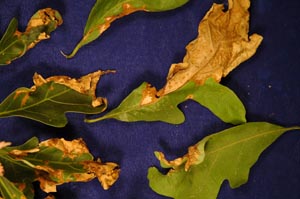Anthracnose Abounds | |
|---|---|
| June 19, 2008 | |
|
I am not certain I could have predicted the extent of anthracnose we have seen on shade trees in Illinois this year. Because the anthracnose fungus thrives in wet weather and cool temperatures, initial infection was expected. Secondary infection does occur, but older leaves are less susceptible to infection by anthracnose fungi, and symptoms are usually masked by healthy new leaves in early June. Because growing conditions were cool for much longer than normal this spring, foliage was susceptible longer than normal. Required leaf wetness has been a common factor in much of Illinois as well. Consequently, we are still seeing sycamores with thinned canopies, and oaks, ash, and maples with many anthracnose lesions. The image shows some oak leaves received by the Plant Clinic. These are from central Illinois and were showing symptoms the second week in June. Why do I have only one oak out of three in my yard that is affected with anthracnose? Why is my maple affected but not my oak? These are common questions concerning anthracnose. There are definitely differences in susceptibility to anthracnose by species and by individual trees. Selections for resistance in oaks and maples have not been reported. The disease may be aesthetically unpleasing in some years (like 2008), but that is not the case every year. In addition, the disease does not significantly affect tree growth. The Platanus species also vary in susceptibility. Severe disease has been reported on American planetree (sycamore), but oriental planetree is resistant. Hybrids and cultivars within a species sometimes show variation in resistance as well. For more information on anthracnose of shade trees, read issue no. 4 of this newsletter or visit Report on Plant Disease, no. 621, “Anthracnose Diseases of Shade Trees,” http://www.ag.uiuc.edu/~vista/abstracts/a621.html. | |
| Author: | Nancy Pataky |

